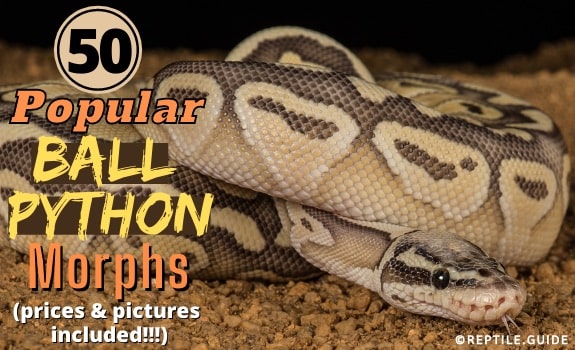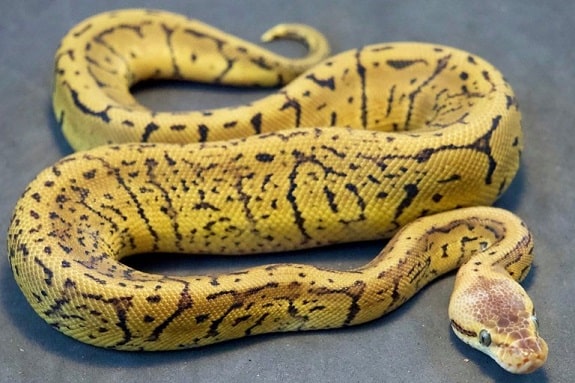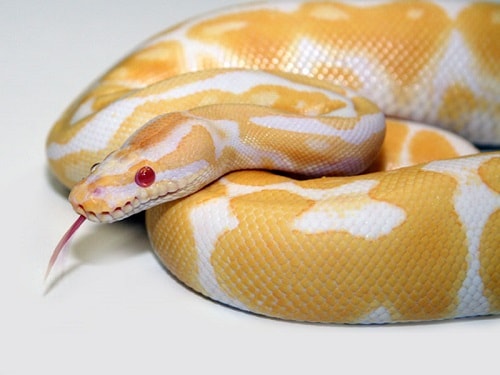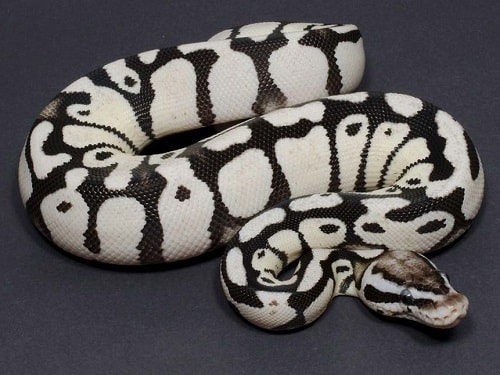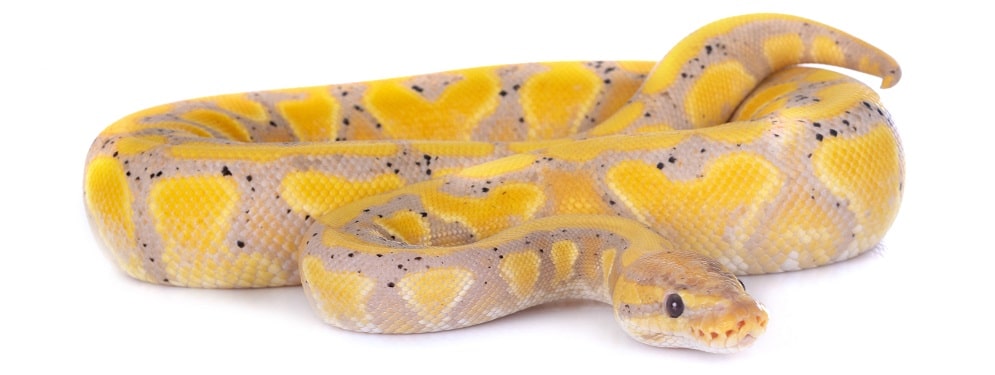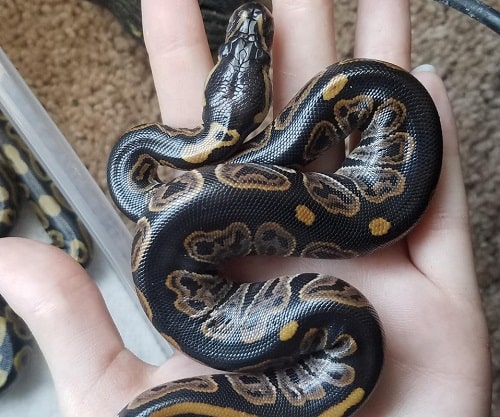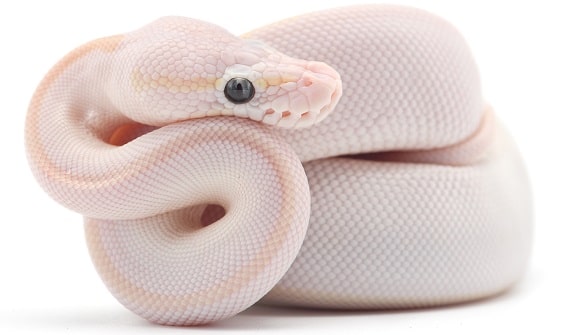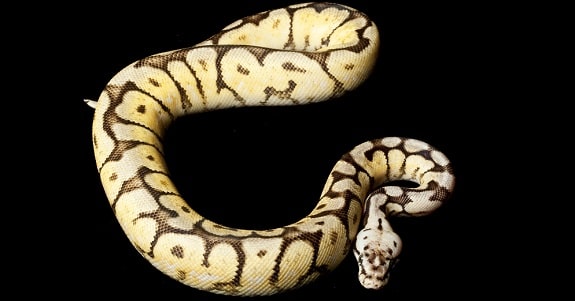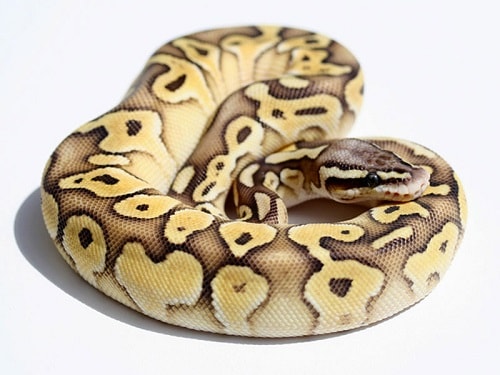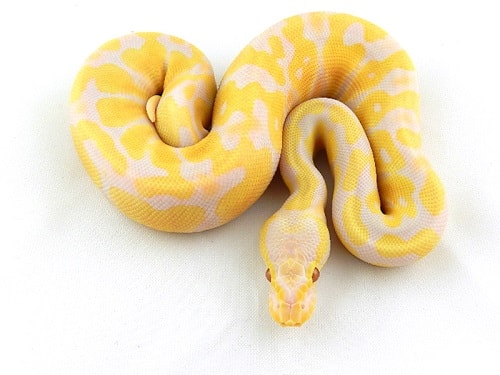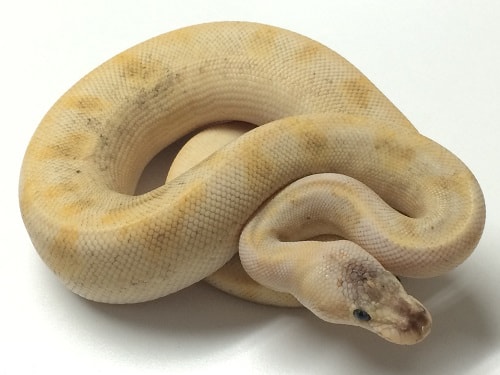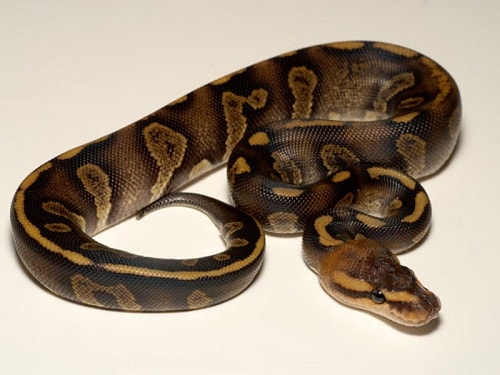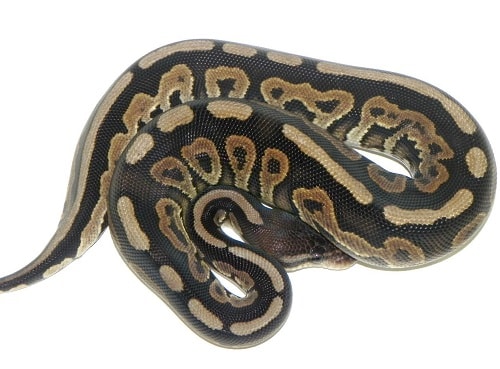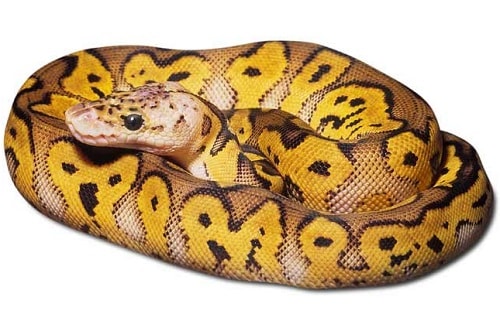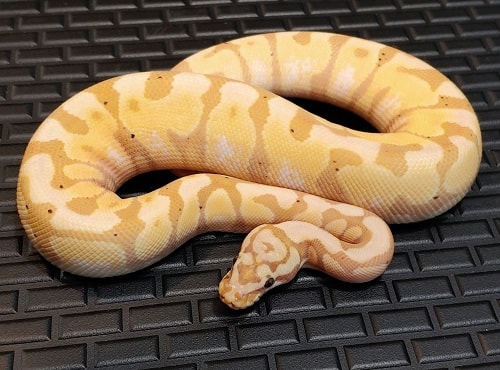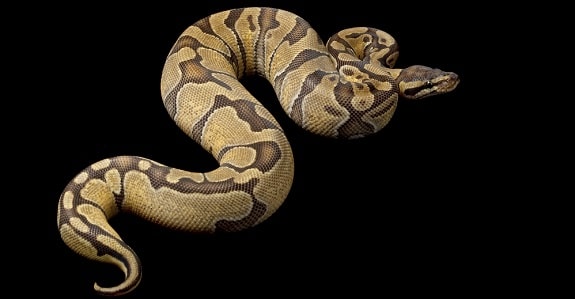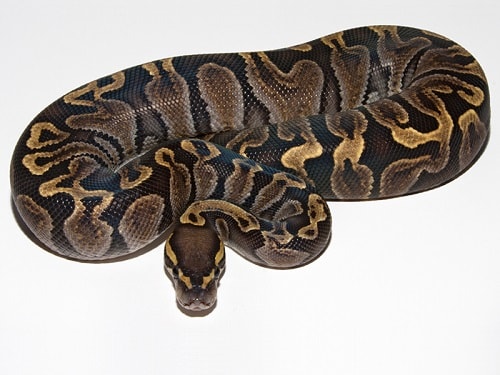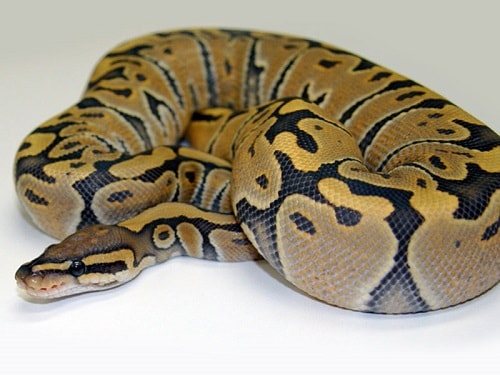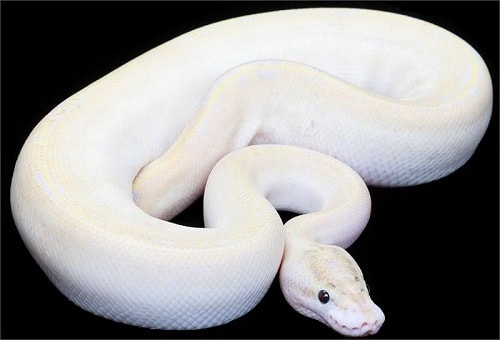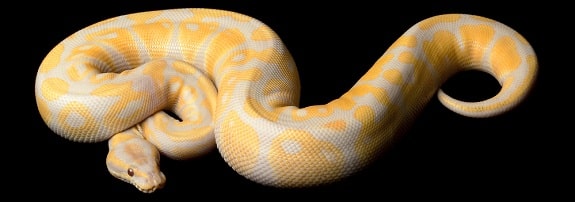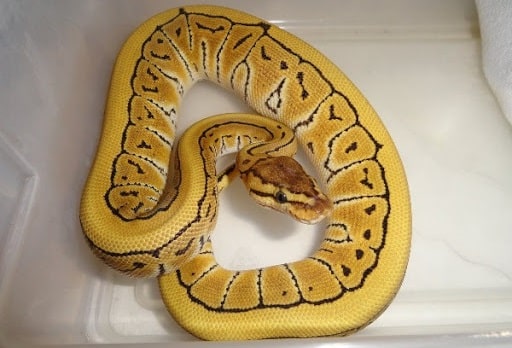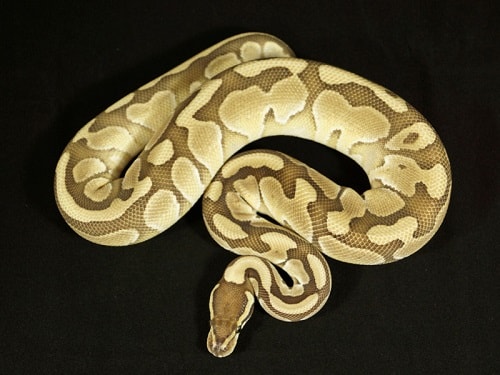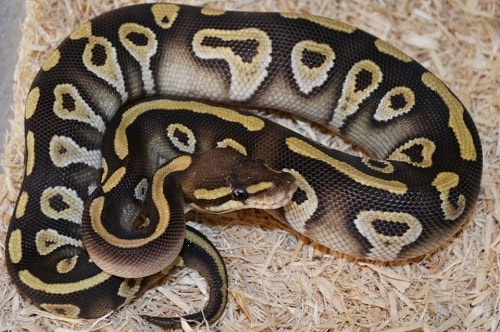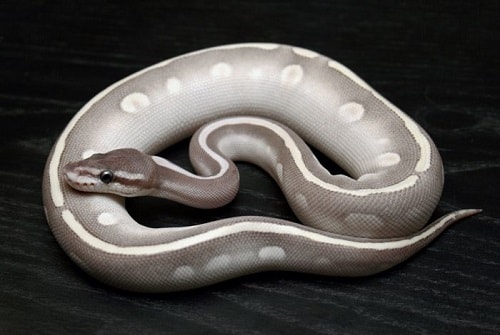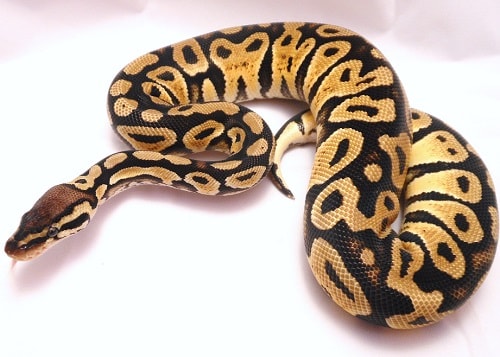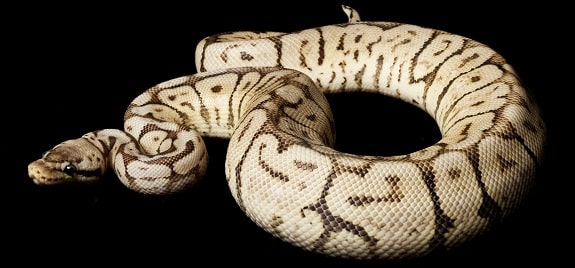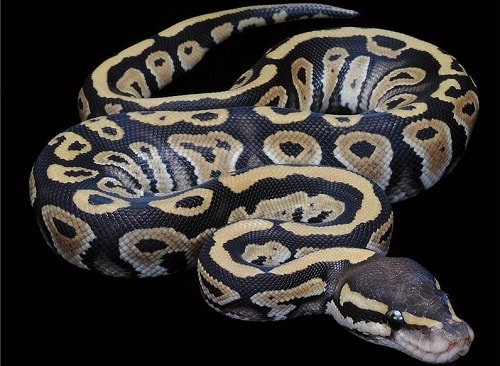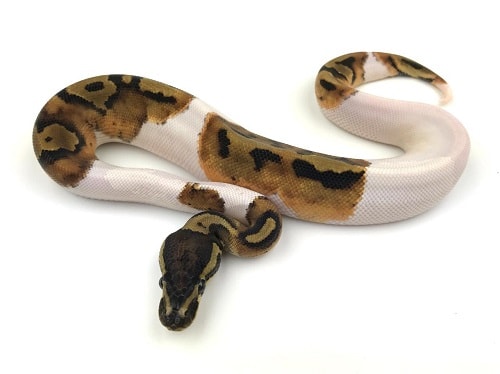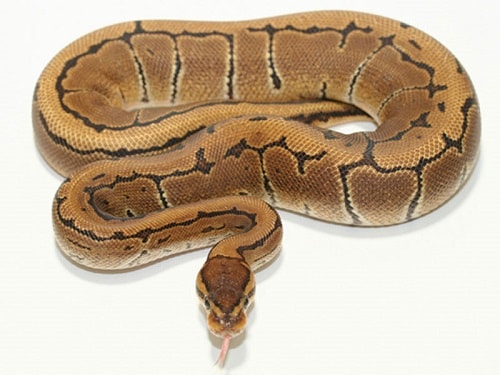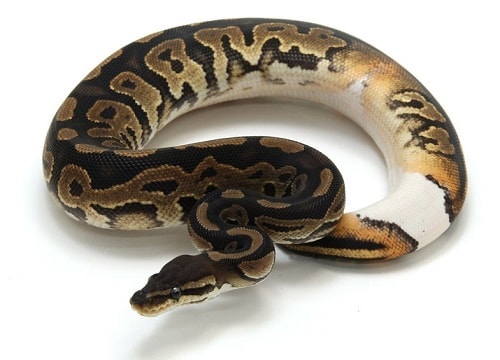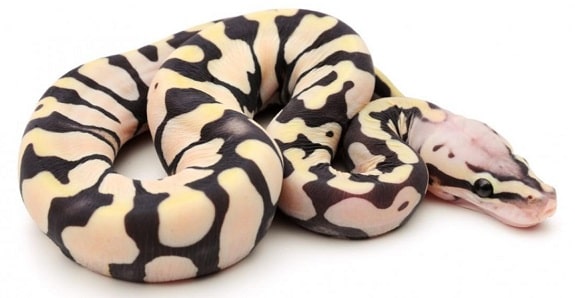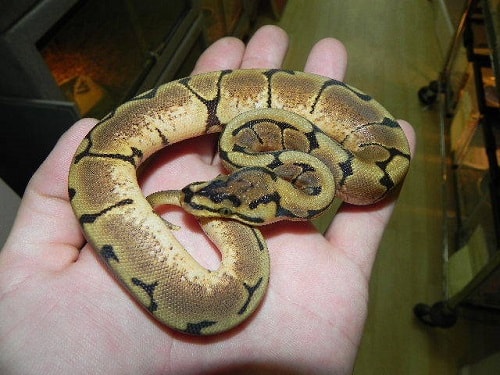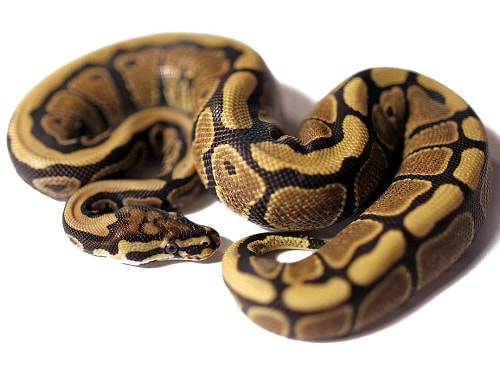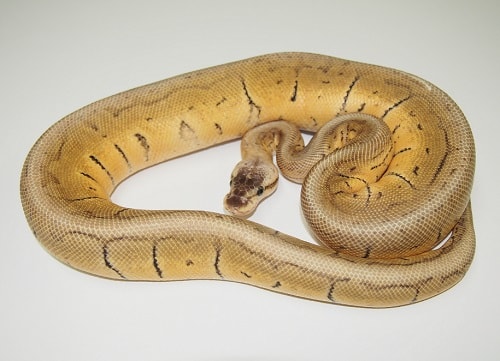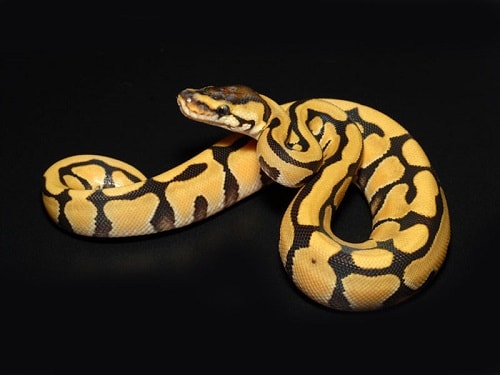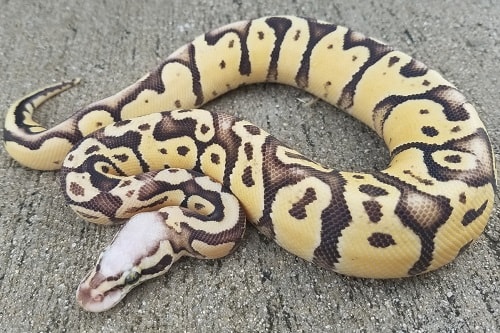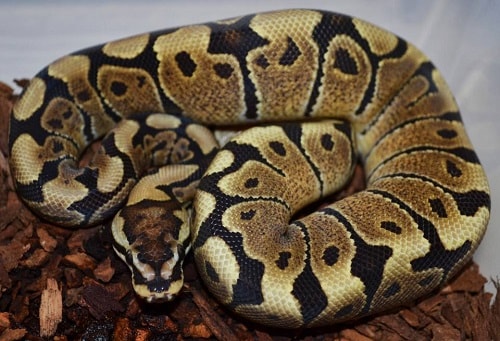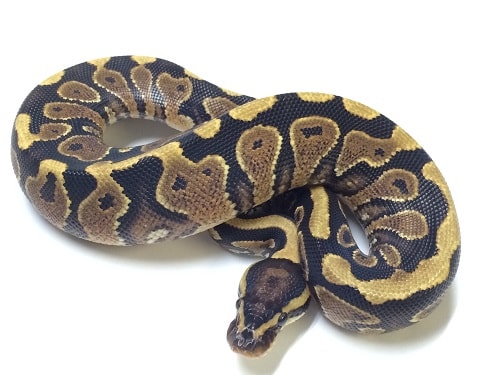When you stop and consider the abundance of ball python morphs that exist, it should become pretty apparent why so many reptile and snake enthusiasts are captivated by this specific breed of snake.
And with an even temperament and manageable size, this fondness (opens in new tab) should be even more clear.
You see, with so many gorgeous morphs to choose from and an easy-to-care for personality and disposition, it’s no wonder ball pythons have exploded in popularity over the last several decades!
Naturally, if you’re considering adopting a ball python, you’ll want to do your homework on morphs. And if you’re on the hunt for explanations, pricing breakdowns, and photos, then rest assured you’ve come to the right place!
✅ Buyer’s Tip: Interested in taking your morphs education to the next level? Considered one of the best authorities on ball python morphs in print, this book is a ball python enthusiast’s dream! It is quite expensive, but you’ll struggle to find better, more thorough information.
In This Article
What Are Ball Python Morphs?
Ball Python morphs are defined as the unique physical appearance of a Ball Python snake that displays a specific color and pattern.
Snake breeders create new morphs by isolating underlying genetic mutations naturally found in the wild. Through selective breeding they are able to create ball pythons with unique colors and patterns.
For instance, an albino ball python with white and yellow scales is a different morph than say a Blue Eyed Leucistic Ball Python that is completely white and without pigment to their scales.
To be a little more scientific, ball python morphs can also be referred to as polymorphism.
Polymorphism is 100% natural and results from a genetic mutation that causes a species’ a physical trait, or the phenotype, to vary in at least 2 different ways.
Polymorphism proves that traits (such as color, size, etc.) can show variance despite coming from the same gene. This is how the same species, with naturally the same genetics, can come to look so different between specific individuals.
To give you another example of polymorphism, consider reindeer and its North American counterpart, the Caribou. Although different in appearance, habitat, and domestication, they are the same species, Rangifer tarandus.
How Many Ball Python Morphs Are There Exactly?
Now, that you have a good understanding of morphs and how they occur, let’s dive into discussing all things ball python morphs! For starters, how many morphs actually exist…
In reality, there are likely to be well over a thousand different morphs, if not even two or three thousand! You see, breeders are crossing different morphs together creating a seemingly infinite variety.
However, because covering all of these would be impossible, you’ll find 50 of the MOST common morphs below. These are the morphs that are most widely recognized and accessible.
Acid Ball Python
One of the newest ball python morphs, the Acid Ball Pythons first made their presence know in 2015 and have increased in popularity year after year, especially amongst breeders.
It isn’t uncommon for ball python breeders to pay a whopping $1500 to get their hands on the gorgeous acid morph.
In terms of coloring, Acid Ball Pythons have a base that is either dark brown or black, with golden brown spots. Meanwhile, their belly is a yellowish shade with a black line running down the entire length resembling that of a zipper.
The dominant gene that creates this morph is very powerful, in fact so much so it is believed to be one of the ONLY ones strong enough to overpower an Ivory morph gene.
In fact, this gene is so strong many breeders describe it as shattering other patterns, which in turn leads to the Acid’s pattern looking somewhat broken.
Albino Ball Python
Famous for their striking yellow and white scales, the Albino Ball Python showcases a recessive mutation that ONLY occurs when both parents carry the gene.
In fact, the Albino Ball Python was actually the FIRST ever recessive morph, created in 1992.
Due to their albino nature, this snake is unable to produce more common ball python colors, such as black, brown, red, and orange.
Just like the Albino Corn Snake, this python is one of the more recognizable morphs with its pink eyes and has become fairly affordable over the years.
Expect to pay anywhere from $200-400 on average for this popular morph.
Axanthic Ball Python (Black and White Ball Python)
Similar to a traditional Ball Python in terms of pattern, this recessive morph offers a different color scheme with predominant shades of silvery grey, white, and black.
Much like albino which cannot product shades of brown, black, red, and orange, the Axanthic Ball Python Morph is unable to produce shades of yellow and red.
In fact, it has often been said that the Axanthic is like an old black and white picture version of the ball python, with a normal ball python pattern.
There are believed to be two different lineages, with one group showcasing some brown coloring as they age.
If you’re looking to purchase a Axanthic Ball Python, expect to shell out around $200.
Banana Ball Python
First discovered in 2003, Banana Ball Pythons have a co-dominant gene that creates brightly colored yellow blotches against a tan base.
They also can have dark colored freckles peppering their bodies.
Popular since birth, breeders have long been churning out these beauties for ball python owners and enthusiasts alike.
Fortunately, since their inception in 2003, they have become considerably more affordable…
Whereas the first Banana Ball Python sold for a whopping $25,000, you can now find them under $200 and seldom ever more than $250.
Since they are co-dominant, they are often bred with other co-dominant morphs, such as the orange dream ball python.
Black Ball Python (Black-Backed)
Believed to be a wild caught snake, the Black Ball Python Morph (AKA Black-Backed Ball Python) has a relatively normal ball python pattern that, upon first glance, may not appear any different.
However, upon closer investigation, you will notice these snakes have a bold and unbroken stripe that runs parallel to their spines.
A Black Ball Python possess a dominant gene that is typically inherited by half of their offspring. However, breeders have yet to capture this gene for future breeding.
A very affordable morph, you can expect to pay anywhere from $50 to $100 for a Black Ball Python.
Black Pastel Ball Python
First successfully bred in 2002, the Black Pastel Ball Python Morph is a co-dominant gene that creates a base color that tends to be a grayish black color.
More often than not, Black Pastels with also showcase a fair amount of blushing.
Flipping the snake over, you may be surprised to notice that Black Pastel Ball Pythons have a totally unmarked underside.
If you’re looking to purchase one, you can do so for around $200 on average.
⭐️ Fun Fact: Did you know? Breeding 2 Black Pastels will give you a Super Black Pastel, which is a darker version that typically showcases a black base color with rusty red colored blotches that create a high contrast against the dark base.
Blue-Eyed Leucistic Ball Python
Undeniably striking, the Blue-Eyed Leucistic or BEL for short, are those that have Leucism, which occurs when there is an absence of pigmentation.
Not found in the wild but a favorite of breeders for years, the BEL Python requires specific breeding from Mojave, Butter, Lesser, Russo, or Phantom Pythons.
But simply breeding the right morphs isn’t enough alone to produce a Blue-Eyed Leucistic Ball Pyhton Morph…
You see, these beauties can actually take a whopping 2-4 generations to be produced! And even after 4 or 5 generations are produced, there’s still NO guarantee that you’ll be left with a perfect Blue-Eyed Leucistic Ball Python.
To date, NO breeders have reported clutches with higher than a 25% success rate.
Seeing as it can take so long and is extremely difficult to produce Blue-Eyed Leucistics, it should come as no surprise they fetch a high asking price.
Finding a healthy, beautiful Blue-Eyed Leucistic for under $800 is rare, with most snakes going for around $900-1,000.
Blue-Eyed Lucy Ball Python
Created by breeding a Mojave Ball Python with a Lesser Ball Python, the Blue-Eyed Lucy Ball Python Morph isn’t truly albino as they have soft yellow dorsal stripes.
This can make them less desirable then their Blue-Eyed Leucistic counterparts, which make sense when you consider their slightly more affordable price point of around $700.
However, one advantage they have over other albino and/or leucistic morphs?
Their eyes don’t possess any light sensitivity.
Bongo Pastel Ball Python
First successfully bred in 2012, the Bongo Pastel Ball Python morph is one of the newest ball python morphs.
This beauty was created by mating a regular single gene Bongo with a Pastel morph.
However, when looking at an adult… you may be shocked to learn that Bongo Pastel Ball Pythons are actually purple snakes when they hatch!
This is because they are quite darker than regular pastels, which many of them appear to resemble a Firefly x Yellow Belly.
However, look a little closer and you’ll likely notice blushing along the back and on back of the head from the pastel morph.
The belly is an off-white and their body is rich in alien heads similar to a regular Bongo morph.
However, due to the pastel gene, the blotches in a Pastel Bongo are noticeably brighter yellow than in that of their regular counterpart.
Seeing as they are somewhat new and not super common, you can expect to spend anywhere from $300 to $500 depending on the breeder and exact coloring and pattern.
Bumblebee Ball Python
With black and yellow scales, it’s no wonder this morph is referred to as a Bumblebee!
Not naturally occurring, you’ll only find this morph from breeding a Spider with a Pastel.
Bumblebees can vary somewhat when it comes to coloring, with some being more yellow and others more cream colored.
Additionally, they are known to have the “Wobble Head” that is common in Spiders.
Extremely bright yellow Bumblebees are referred to as “Killer Bees” and unlike other morphs, actually keep their vivid color as they age.
If you’re interested in a regular old Bumblebee Ball Python morph, you can find them for sub $200. However, the Killer Bee, one of the more rare ball python morphs, can typically run you as much as $500.
Butter Ball Python
Perhaps a no brainer, but the Butter Morph is named for the buttery yellow and caramel colored scales it creates.
First isolated in 2001, Butters possess co-dominant genes.
When bred together, two Butters can even create a Blue-Eyed Lucy, although this is outcome is somewhat rare and can take several generations.
More often than not, two Butters will create a Super Butter morph that is a pale yellow color.
With an obvious Ball Python pattern, you can spot a Yellow by the smoothness of its scales, the general yellow color, and its white underbelly.
Butters are generally pretty affordable and can be purchased for around $100.
Candino Ball Python
Created by breeding an Albino with a Candy, Candinos are a rarity and can be identified by their super bright yellow blotches and grayish pink or lavender base.
A true designer morph, you won’t find Candinos in the wild as they only occur from two recessive genes found in the aforementioned 2 other morphs.
As you might suspect with any designer morph, Candinos can fetch a higher asking price, typically between $300 and $400.
Candy Ball Python
Unlike 99% of the morphs on this list, Candy Ball Pythons actually increase in value as they age!
This is due to their changing colors that start out albino at birth, but quickly turn dark lavender, beige, and gray in base with gorgeous bright yellow blotches as they grow older.
The Candy ball Python was first recognized in 2009 and shares co-dominant patterns with both the Toffee Ball Python and Albino Ball Python morphs.
Created in 2009, this is one of the newest ball pythons on this list.
As such, they can cost on average around $350, but don’t be surprised if you see them going for much higher.
Champagne Ball Python
With no clearly distinguishable pattern, Champagne Ball Python morphs are a Co-Dominant mutation discovered in 2005 that showcases tan or orange colored scales and a white underbelly.
Sometimes referred to as a “Puma”, Champagnes comprise one of the more unique patterns simply because they don’t really have one.
Because of this, they are primarily used by breeders to make other morphs or test for Co-Dominant morphs.
When bred with other morphs, they have the unique ability to reduce patterns in offspring or sometimes brighten them as well.
Champagnes are pretty common as their standard $200 price tag should indicate.
Chocolate Ball Python
Rich and indulgent in color just like a fudgy brownie, a Chocolate will have darker brown and black pigmentation with a distinctive healthy sheen to the scales.
They’re a pretty basic morph with a normal head color and pattern and have been popular since they were first recognized in 1999.
However, they do possess gorgeous keyholes that are caramel in color and alien heads that are balloon shaped.
Regular Chocolates tend to go for $100 or less, but more intense color variations can cost easily 2-3X that.
Cinnamon Ball Python
Discovered in 2002, a Cinnamon Ball Python morph lives up to its name with a dark brown base and rich reddish-brown coloring that is offset by bronze colored alien heads and rings that can be heart shaped.
Formed from co-dominant genes, two Cinnamons that are cross will create a Super Cinnamon, which turn a grayish-brown with age. They also have no pattern and a light underside.
For your average Cinnamon Ball, expect to pay around $75. But for a Super Cinnamon? Be prepared to at minimum 5x this price as they regulalry fetch between $400 and $500.
Check out our dedicated cinnamon ball python morph guide to learn more about this morph and whether it’s right for you.
Clown Ball Python
With a unique pattern and coloring, it should come as no surprise that the Clown Balls are the result of powerful recessive mutation that can make one appear quite different from the next.
Discovered in 1999, their coloring is typically brown and tan and can show shades of copper that fade out as they reach their belly.
Believed to be named for the unusual pattern found on the face that resembles face paint, Clowns also tend to have a blushing coloration on their dark dorsal striping.
The dark patches also tend to end in teardrop shapes towards the under belly.
However, the real showstopper is the head which can feature both light and dark scales.
If you fancy a Clown Ball Python, you should be prepared to spend around $200.
Coral Glow Ball Python
Discovered in 2002, Coral Glow Ball Pythons or “White Smokes” as some call them, are an extremely well known hypomelantistic morph.
Coral Glows display a beautiful lilac and greyish base coloring with gorgeous orange blotches that fade into yellow, giving them a glowing look, hence their name.
They are co-dominant and can even change in coloration as they age, as some will develop tiny black spots that pop up like freckles.
And although they have been around for awhile now, it isn’t uncommon to find a Coral Glow costing $300 or more.
Dreamsicle Ball Python
Another designer ball python morph, Dreamsicles are gorgeously complex and on average, can take 2-4 generations of breeding to achieve.
This morph is VERY difficult to achieve because it requires crossing the Albino-Lavender with Piebald genes, all of which are recessive.
Their base is often a pinkish-white with a soft cloud pattern than is randomly scattered down the body.
Their blotches are a dreamy bright orange shade and are vividly defined.
They have been extremely popular since 2007 and still to this day can fetch an asking price of $2,500 or more.
Enchi Ball Python
Discovered as a breeding pair in 2002, the Enchi Ball Pythons actually hail to us all the way from Ghana, Africa!
With brighter colors than normal ball pythons, particularly in their orange sides, Enchis also showcase more blushing and a round pattern on their head.
They are co-dominant when crossed with other morphs which creates offspring with vividly defined patterns. And although at birth the coloring may appear subtle, it will only intensify more and more as they grow older.
Today, one can purchase an Enchi for around around $100, give or take. However, some rare yellow enchi morphs can cost between $2,000 to $5,000!
Find out more in our dedicated enchi ball python morph guide.
Fire Ball Python
First bred in 1995, the Fire Ball Python is often used to make Blue Eyed Leucistics and as such, are MUCH lighter than that of a regular ball python with Co-Dominant genes
You can expect a Fire to have a reduction in both its brown pigmentation AND pattern. As such, a Fire has more tan than a Normal, as seen in its coffee colored, thinly banded pattern.
When two Fires are bred, a Super Fire is created in which the colors are much more fiery.
Often referred to as Black-Eyed Leucistics, Supers have a white base with yellowish spots and blood red eyes.
A regular Fire will often set you back around $100, but a Super Fire can go for as much as $400.
Fire Ivory Ball Python
Perhaps a no brainer, but the Fire Ivory Ball Python morph was created when an Ivory and a Fire were crossed in 2012.
However, because Ivories are created from two co-dominant Yellow Bellies, the unique Fire Ivory is actually the result of three separate genes (Yellow bellies, Fire, and Ivory).
With a lavender and pink colored base, these gorgeous snakes possess a dusty gray blushing and are essentially patternless, with the exception of a sole yellow stripe that runs down the middle of their back.
Regular beauty queens in their own right, the Fire Ivory morph will set you back at least $300, but can easily fetch $400 or more.
GHI Ball Python
Another relatively new morph, the GHI or “Gotta Have It” Morph is one of the more rare ball python morphs and an exciting find that was first discovered in 2007.
The result of co-dominant genes, the GHI is dark in nature, with a black base and highlighted blotches that can range from golden brown to orange brown.
Their blotches are also characterized by dark specks. As you look towards their belly, you’ll notice their base color started to fade out in between the blotches, with silver flames towards the edges.
If you’d like to purchase a regular GHI, you can find them for around $200, give or take.
Ghost Ball Python
Like a chilly night close to the sea, the Ghost Ball Python morph appears hazy with muted colors that almost look as if they could be faded by a layer of fog.
This coloring is referred to as “Hypomelanistic Coloration”.
Their coloring tends to be yellowish tan and they may even have grayish colored flames along their belly.
Although Ghost Ball Pythons tend to resemble shedding ball pythons due to their muted coloring, their pattern is normal and fairly simple.
For a Ghost, buyers should be prepared to spend around $100.
Highway Ball Python
Another designer morph, the Highway ball Python came to us when a Yellow Belly was crossed with a Gravel.
Highways are unique in that they can vary quite a bit from one snake to the next. For instance, some have a warm brown base and others can have more of a pastel yellow. Some have rings and others are solid.
However, one thing ALL Highway morphs do have in common? A yellow stripe that runs down their spine and appears broken.
Sometimes, these stripes can be shadowed as well, which makes their pattern seem even brighter.
As one might suspect, the more striking the contrast in a Highway’s coloring, the higher the asking price.
You can expect to pay anywhere from $500 to $700 for your typical Highway.
Ivory Ball Python
The super form of a Yellowbelly, the Ivory is a striking off-white snake that contains beige and peach coloring and can sometimes be mistaken when young for a BEL.
Also referred to as a “Super Yellow Belly”, Ivories are a designer morph with Co-Dominant genes.
If you examine their heads, you’ll typically notice a grayish lavender blushing, although some Ivories have been known to have dark or bright spots on their head as well.
An Ivory Ball Python will typically set you back between $250 and $300.
Lavender Albino Ball Python
The result of a combination of both recessive Lavender AND Albino genes, the Lavender Albino Ball Python exhibit a gorgeous color mutation that, when first discovered in 2001, actually warranted a whopping $40,000 sale!
So, what exactly makes these snakes such beauties? Well, to start their soft lavender base contrasts beautifully against bright yellow blotches.
Additionally, their piercing red eyes give them a fiercely beautiful stare many breeders only dream of producing!
Have your heart set on owning a Lavender Albino morph? They’ll cost you a pretty penny at around $400.
Lemon Blast Ball Python
First created in 2003, the designer morph Lemon Blast is the result of a cross between Pinstripe and Pastel genes.
Most notable on the Lemon Blast, is the bright yellow base that is offset with a a linear pinstripe pattern, that consists of a black and dark brown pattern.
However, in some Lemon Blasts you’ll also see a rich orange base without a pattern on the spine.
If you want to purchase a Lemon Blast, you may be able to find them for as low as $150, but you should be prepared to spend closer to $200.
Lesser Ball Python
First bred successfully in 2001, the Lesser Ball Python morph is pretty similar looking to a Butter, but it will have a slightly more brown coloring to it.
The base color will be a soft brown that may appear to blush and lighten, especially towards their belly. Their head will appear pretty similar to a normal ball python but with a softer brown coloring.
Lessers were revolutionary at the time of their inception, and originally sold for as much as $30,000! However, today breeders can produce them with little to no trouble at all.
In fact, as one of the most affordable morphs on our list, you can purchase a lesser for as low as $100!
Mojave Ball Python
Successfully bred for the first time in 2000, the Mojave is a real site to behold with their unique bright yellow design and white underbelly.
Often a favorite of breeders, Mojaves are Co-Dominant mutations and renowned for their ability to produce many different kinds of morphs, such as Blue Eyed Leucistics.
They tend to be very easily recognizable with a dark brown or blue-black base coloring and flaming that can range from creamy tan to bright yellow and rich brown.
They share a similarity with normal ball pythons in their alien head pattern, but their flames differ in that they contain a sole keyhole.
Once a very expensive morph, Mojaves now can be purchased for around $100, give or take.
Mystic Ball Python
With high contrasting colors, the Co-Dominant Mystic Ball Python is by NO means a dull looking morph, but it also isn’t as bold or bright as some others.
With Mystics, you can expect them to resemble Mojaves somewhat with less bright coloring.
First bred in 2005, the Mystic actually changes quite a bit in coloring as it ages, often times being born with a dark brown or black base that will lighten as they grow older.
As an adult, your Mystic will showcase a striking grayish purple base with a pattern that has essentially no alien heads.
When it comes to their heads, they tend to be quite dark in color with little to no blushing.
If you’re interested in purchasing a Mystic, expect to spend between $100 and $150.
Pastel Ball Python
A Co-Dominant mutation, a Pastel Ball Python morph is one of the MOST popular morphs you will find today.
First bred in 1997, the Pastel has a brown base that often appears to be blushing. Their belly is white and their eyes are a soft green color, almost like the kind you’d see in cartoons!
Their blotches showcase intense yellow pigmentation, however they can become more brownish yellow as they age.
Breeders LOVE Pastels because they can be used to brighten up yellow and recessive genes.
When you breed two Pastels together, you’ll achieve a Super Pastel Ball Python morph.
Super Pastels actually vary in appearance a decent bit from that of a regular Pastel morph…
They have a muted yellow pattern with a purple blushing color that is often referred to as “Purple Haze” by breeders and enthusiasts.
On top of this, their pattern is chaotic, with a little bit of banding, and more keyholes than that of a Pastel.
If you have your heart set on purchasing a Pastel, you’ll be happy to know they tend to cost just $75-$100. Meanwhile, Super Pastels will run you a little more, typically around $150.
Pewter Ball Python
Created in 2003 by crossing a Pastel with a Cinnamon, the designer Pewter Ball Python morph is characterized by a light brown base with a thick stripe that runs down the spine.
Pewters often have yellowish-golden keyholes that are outline in dark brown or black with similar colored centers. Their pattern can vary a bit from snake to snake, with some having highly erratic patterns.
However, despite the variance in pattern… you will typically find the color scheme for Pewters to be pretty standard.
For around $200, you can purchase a Pewter.
Phantom Ball Python
Extremely dark but not quite black, Phantoms have a rich black-brown base with dark yellow alien heads and black spots.
They can often be confused for Mojaves, although their genes are closer in nature to that of the Mystic.
However, Phantoms will tend to have less blushing than Mojaves and more brown coloring.
You’ll likely also notice spots on the spine and the stripes that lead toward their tails.
They were first bred successfully in 2001, although they weren’t recognized until 2005.
If you’d like to purchase a Phantom, you can do so for around $100.
Piebald Ball Python
Perhaps one of the most unusual and most rare ball python morphs, a Piebald Ball Python morph is easy to identify due to its long, milky white body that separates areas of normal coloring from one another.
A Piebald is kind of like what you would get if you took a magic eraser and removed the coloring of a Ball Python in the middle and left only their normal pattern on the head and towards the tail.
However, despite this highly irregular pattern, Piebald ball pythons almost always have a normal looking head.
Created in 1997, the Piebald’s unique pattern is, perhaps unsurprisingly, the result of a recessive gene.
Today, you can purchase a Piebald for around $300 on average.
However, you should expect this price to go up when they are mixed with other recessive traits that produce striking color combinations and patterns.
Pinstripe Ball Python
A Dominant gene, the Pinstripe Ball Python morph was first recognized in 2001 and is named for the long stripe that runs down its back.
This stripe is actually beloved by breeders who regard it as a GREAT way to dramatically alter patterns in offspring. For instance, when crossed with Pastels, Pinstripes can help create the relatively newer morph Lemon Blast.
In terms of color, you can expect a Pinstripe to have a rich caramel to copper base with a patternless stripe that runs from head to tail.
Often times they also have skinnier striping that is perpendicular to their back stripe, as well as lighter colored flames.
A regular Pinstripe will typically cost you a little more than $100.
Purple Passion Ball Python
What do you get when you cross a Mojave’s co-dominant gene with a Phantom? You get the absolutely stunning Purple Passion Ball Python morph that was first bred in 2007!
These beauties have a creamy lavenderish-pink base without any patterns on their sides.
However, some can have broken up, disconnected blotches with keyholes, though this tends to be pretty rare.
On their spine runs an off-white stripe that is contrasted beautifully against their dreamy base color. Their eyes are a piercing dark brown or black.
You can purchase a Purple Passion Ball Python for around $400 to $500.
Red Ball Python
Another relatively basic morph, Red Ball Pythons appear very similar to that of a normal ball python, with the sole exception of their coloring.
You see, a Red Ball Python morph is created with a dominant trait that alters their coloring as they age, often times tinting their blotches a deep red.
Breeders LOVE using the Red morph to produce offspring that showcase rich red and copper hues.
Since this morph is pretty simple in nature, you can expect to pay around just $100 for a Red Ball Python.
Ringer Ball Python
Similar to the Piebald, Ringers tend to have an area where the color dissolves into milky white scales.
However, these sections tend to be much smaller than those found on a Piebald.In fact, the area typically tends to be in the tail and is usually around just 5% of the snake.
They are born to normal ball python parents and are often used by breeders to expose which snakes may carry Pied genes.
As such, if you have a Ringer, it could be a het pied (possess the Piebald gene), but it’s not guaranteed.
Standard ringers can cost around $100.
Scaleless Ball Python
First bred in 2013, the Scaleless ball Python Morph is perhaps the most unique morph on this list! A relatively newer morph, these unique beauties were created from combining Scaleless Head morphs.
As you may have already guesses, they actually are lacking in scales and instead have skin. However, this can vary from snake to snake as some will have zero scales and others will have just a few small patches of skin.
However, ALL Scaleless Ball Pythons have scales on their bellies. This allows them to safely and comfortably move along the ground without injuring their belly.
A definite investment, a Scaleless Ball Python will typically set you back several thousand. Expect to spend around $2,500 to $3,000 acquiring one.
Read our complete guide on Scaleless Ball Python to explore more about this interesting morph!
Spider Ball Python
A dominant mutation, a Spider Ball Python morph first made its debut in 1999.
Spiders have a base color that is light tan to medium brown that goes pale on their spine.
In terms of pattern, they possess thin, dark brown or black bands and spots with a distinctively marked face and top of the head.
They almost always show a noticeable reduction in their dark markings.
Spiders can be used to create many other morphs, but may present some neurological issues as they can suffer from the “Head Wobble”.
A very popular and in-demand morph, you can purchase a Spider for between $100 and $150.
However, it’s worth mentioning that many breeders consider the Spider Ball morph to be unethical due to the inherited neurological issues mentioned above.
We suggest learning more about this morph through our Spider Ball Python guide before you decide to purchase one.
Spotnose Ball Python
With spots on both sides of its nose, the Spotnose Ball Python morph is one of the more aptly named morphs on this list.
A Co-Dominate gene, the Spotnoses was created in 2005 and displays a pattern typical of ball pythons BUT with more alien heads and a more dramatic faded light brown coloring.
At first glance and to the uneducated eye, a Spotnose might be believed to be a normal ball python.
When bred, their gene only affects the pattern and color on their offsprings’ heads, making their genes pretty weak overall.
You can purchase a Spotnose Ball Python for around $125.
Stormtrooper Ball Python
The result of sheer luck, the Stormtrooper Ball Python morph was an accident that was first created in 2015. At the time, the breeder had intended the morph to be a Pastel-Axanthic.
In terms of coloring, a Stormtrooper has a pure white base with pitch black bands that can vary in thickness.
As you might have already guessed, their coloring exactly matches that of the Star Wars character.
However, the Stormtrooper is still a chaotic morph that has yet to be stabilized and controlled by breeders.
In fact, over time its coloring has darkened, with more and more snakes being born with blacker coloring and less white. Their genes are referred to as the “Darkness Gene”.
To date, it’s pretty much impossible to purchase a Stormtrooper.
But if you want to learn more about this fascinating morph, our comprehensive Stormtrooper Ball Python Morph Guide has got you covered.
Sunset Ball Python
Created in 2012, the Sunset Ball Python morph was created from basic morphs… so imagine the surprise of the breeder when it hatched!
This snake is essentially a fiery sunset personified, with its auburn base color and copper blotches and deep red head.
Given the beauty of this rare ball python morph, it should come as no surprise that the first Sunset Ball Python was actually sold for $70,000!
Now that the gene has been stabilized and controlled by breeders, the price has come down significantly.
However, you’ll still spend a pretty penny as your typical Sunset Ball Python will cost you upwards of $1,000.
Super Blast Ball Python
Bred from a Pinstripe and a Super Pastel, the Super Blast Ball Python morph has a diluted, bright yellow base with very thin black lines that run vertically down the sides.
They also have a light colored stripe that runs down their spine.
Their head often has dark spotting on it which contrasts dramatically with that of their lighter colored body.
With their striking appearance, you might be surprised to learn a Super Blast Ball Python is actually fairly affordable…
You can purchase them for as low as $200 online, although $300 and up is more common.
Tiger Ball Python
Often referred to as the “Desert Enchi”, the Tiger Ball Python morph is created by combining the co-dominant Enchi gene with that of the dominant Desert morph gene.
Tiger morphs displays an irregular pattern in which it appears to have bands around its back from the dark black patches that stretch across it.
A Tiger is similar to that of Spider and Banded in that they both appear to have sections of black that stretch entirely across their backs. Although, Tigers bands tend to be much thicker and a darker black than that of a Spider.
For a base color, Tigers are a bright yellow, although this will often times fade into a deep orange as they age. A Tiger’s head is dark, although the sides of the head and mouth tend to be lighter in color.
As with most morphs, price will vary somewhat depending on color intensity. Regular Tigers tend to be pretty cheap, it’s not unheard of to find one for sub $100.
Vanilla Ball Python
A Co-Dominant morph, the Vanilla Ball Python morph was discovered to be genetic when two light normal ball pythons were bred together.
Lighter than normal, the Vanillas demonstrate normal patterns but tend to become lighter and lighter over time.
Their base consists of various shades of brown that appear to be blushing. Their heads are a faded brown. However, you can often see them with blush heads like a Pastel as well.
Vanillas are popular with breeders as they can help create vibrantly colored offspring.
Today, Vanillas have a really affordable price point and can be purchased for around $100.
White Ball Python
Created in 2007 out of accident, the White Ball Python Morph are totally white, making them the “cleanest” of the Leucistics.
As such, their scales are totally lacking in pigment. In fact, the only color on their body are their dark brownish black eyes.
Today you can purchase a White Ball Python for $600-$700.
Woma Ball Python
Often times resembling that of a Normal, the Woma Ball Python morph is a basic morph that was first created in 1999.
The Woma Ball Python can be distinguished from a normal due to its thin banded pattern, yellow lips, and clean belly. In fact, it was actually named the “Woma” after the Woman Python which also showcases a banded pattern.
As a Dominant gene, the Woma is beloved by breeders for its ability to produce really unique and striking mutations. However, it isn’t the easiest morph to breed…
You see, the Woma produces offspring that vary from clutch to clutch in terms of appearance. So, trying to highlight or diminish specific traits can be difficult.
Additionally, they can’t be bred amongst themselves as Super Womas tend to suffer from health problems and live a short life.
Today, you can purchase a Woma for as low as $150, although $200 is more common.
Yellow Belly Ball Python
If you’re not looking closely, you may just miss this morph entirely!
Co-Dominant, the Yellow Belly Ball Python morph can look quite normal, with the exception of a slightly yellowed, clear colored belly.
However, some Yellow Bellies can look more dramatic as well, with rich coloration and a checker pattern on the edge of their underside.
When it comes to breeding, many breeders love Yellow Bellies for their ability to create highly pigmented offspring when bred with specific morphs.
You can purchase a Yellow Belly Ball Python for as low as $50.
How to Identify Ball Python Morphs
Naturally, when you’re trying to figure out how to identify ball python morphs, you’re going to typically want to look at a few common things with every snake.
Knowing the following areas of interest will help tremendously when trying to identify different morphs.
Tip #1: Look At Their Overall Color
When looking at the body of the snake… what colors tend to stand out?
How about the saturation and intensity of these colors?
If you can develop a keen eye for coloring especially in regard to distinguishing similarly colored snakes from one another (think a Lesser and a Butter), you’ll pretty much have the hard part down.
You see, when deciding what to call a specific morph… color is essentially the FIRST thing breeders consider! So, know your colors and you’ll know your morphs.
Tip #2: Examine Their Pattern
Next to color, I would venture to say being able to spot pattern differences amongst morphs is about the surest way to distinguish them from one another.
You’ll want to look at a number of things when examining pattern…
For starters, examine the alien heads on the snake.
How are they shaped?
Do they tend to have 1 or 2 eyes in them?
Next, move on to the flames. You can find the flames by looking for lighter areas that come up the sides from the belly, they kind of resemble flames.
Lastly, you’ll also want to consider the overall shape of the markings that run down the dorsal. For instance…
Are there stripes, bands, blotches, or something else?
Tip #3: Look for Blushing
Although not one of the more important physical differences to note, blushing can prove helpful with some morphs. First, let’s make sure you understand what “blushing” refers to in ball pythons…
Blushing refers to the changing in color of the pigment that runs down the dorsal (spine) of a ball python. Blushing can appear lighter or darker, than the surrounding colors and can also be seen on the head of some morphs as well.
To see how helpful blushing can be, look at the picture of the Phantom and Mojave below. Pretty similar, right? Where you can really tell one from the other, is by noticing the variation in blushing.
See how the Mojave (left) has more of a noticeable blushing from dark brown to lighter brown along the back?
Tip #4: Pay Attention to Eye and Head Color
Although examining the eye and head color won’t always help you instantly identify a morph, it can be helpful. For instance, some snakes will appear similar but have slight differences in the coloring of their heads, such as with the Vanilla’s blushed head that makes it obviously different from a normal ball python.
Most Common Ball Python Morphs
The most common morphs are going to naturally vary over time…
For instance, decades ago BEL were ALL the rage and breeders were producing them at a lightening pace.
However, whereas the BEL used to be a $20,000 snake during its peak in popularity, you can now expect to pay around $1,000 to $1,500 on the high end. You’ll also see less of them in rotation as well.
Today, the Most Common Morphs Include:
- Pastel
- Fire
- Spider
- Pinstripe
- Mojave
Most Expensive Ball Python Morphs
Naturally, the most expensive ball python morphs are going to be ones that are extremely rare.
As such, it should come as no surprise that when you produce a new morph, you can pretty much charge as much as you want!
You’ll find a lot of instances online where people claim to have heard about ball pythons costing as much as $100,000 or even $200,000… but there isn’t much tangible proof to back this up.
Most of the morphs on the list above are pretty affordable since they are the most common or single gene morphs.
However, there are many unique morph combos that have created snakes that cost well into the thousands of dollars…
According to Forbes, a female Lavender Albino can sell for as much as $40,000, whereas a Striped can command as much as $20,000.
When you’re browsing online, you might come across listings for the Sunset ball Python, which was only invented several years ago. It has even been reported that a Sunset Ball Python can sell for up to $10,000.
And lastly as one final example, Coral Glows can be quite expensive with females costing as much as $10,000 and the rarer male even more than that.
Cheap Ball Python Morphs
Naturally, a regular ball python is going to be the cheapest, with some selling for less than $10.
However, if you have your heart set on owning one of the more colorful ball python morphs, rest assured there are a variety of ball pythons that are relatively inexpensive.
In fact, there are many ball python morphs available for under $150… and in some instances? Sub $100 as well!
Cheap Ball Python Morphs:
- Yellow Belly
- Cinnamon
- Tiger
- Vanilla
- Ringer
- Phantom
- Mojave
- Pastel
- Lesser
- Butter
- Enchi
- Ghost
- Black
What Ball Python Morphs Have a Wobble?
As a neurological condition present in several different morphs, “The Wobble” affects the motor skills of a ball python typically in the head or neck.
The Wobble can vary in terms of intensity from snake to snake…
Some snakes have very little Wobble and as such, can experience a pretty normal quality of life. Other snakes can have a Wobble so dramatic, they may struggle with eating and even staying upright. However, in extreme cases typically a snake with Wobble will just struggle with striking accurately, so be careful when hand feeding!
Fortunately, the Wobble doesn’t really present any serious issues, but it can become exaggerated with stress so try to keep them calm and happy.
The Morphs Most Likely to Have The Wobble Are…
- Spider
- Champagne
- Bumblebee
- Woma
- Hidden Gene Woma
- Super Sable
- Power (AKA a Super Spotnose)
Wrapping Up Ball Python Morphs
As you can now see, there is truly an infinite number of ball python morphs available once you start including all of the possible combos and unique pairings breeders experiment with. And when it comes to appearance, well, you can pretty much expect an infinite number of possibilities with this as well!
However, when it comes to narrowing down the playing field, you can expect the aforementioned 30 morphs to represent the majority. If you are somewhat familiar with these 30, you should be at least somewhat decent at identifying morphs.
Just remember to consider the overall color and pattern (specifically, alien heads, flaming, and shapes) above all else when trying to distinguish one morph from another.
Ball pythons are not the only snakes with morphs – check how the western hognose snake can look and how to care for it!
But if you somehow just can’t get enough of ball pythons, then check out our collection of fascinating ball python facts or the viral rainbow python!
